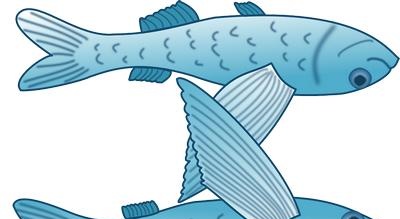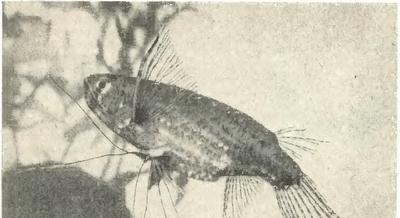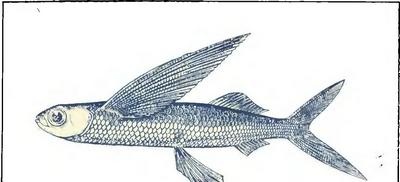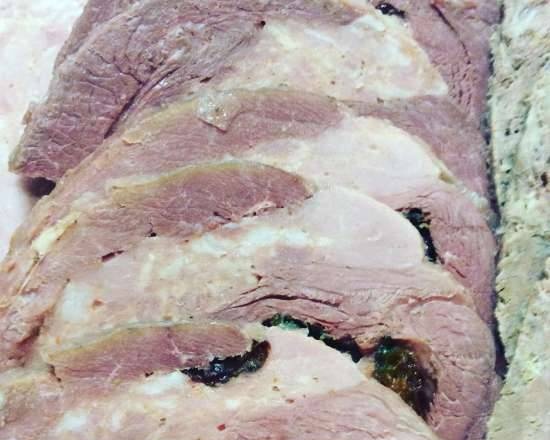|
 Warm waters of the World Ocean greet the navigator with a bright sun, blue transparent water and schools of flying fish that glide easily over the waves. Flying fish, which have always attracted the attention of researchers, are singled out as a separate family Exocoetidae of the order Sarganiformes (BeloniFormes). Warm waters of the World Ocean greet the navigator with a bright sun, blue transparent water and schools of flying fish that glide easily over the waves. Flying fish, which have always attracted the attention of researchers, are singled out as a separate family Exocoetidae of the order Sarganiformes (BeloniFormes).
“All representatives of this order,” writes N. V. Larin, “live in the surface layers of water, and many of them, fleeing predators or pursuing prey, jump over the water. In flying fish, these jumps in the course of evolution were transformed into gliding flight, reaching a considerable duration and range. " The ability to fly, although less perfect, is possessed by some species of other families of this order, for example flying half-fish (Oxyporhamphus) and oceanic semi-bird (Euleptoramphus)... To understand the reasons for such an unusual way of movement for fish, you should familiarize yourself with their environment and way of life. The range of flying fish is mainly located in the tropical region of the World Ocean. All flying fish are thermophilic and live in water with oceanic salinity at temperatures of 25 ° and higher. There are few of them in the subtropical zone. They inhabit the most superficial layer of tropical waters to a depth of three meters (they never go below), and most of them stay in the upper layer about 25 cm thick. The sizes of flying fish are small - from 15 to 25 cm (without the tail fin). The length of the largest flying fish (with a tail fin) does not exceed 50 cm.
Flying fish belong to the group of "short cycle" fish. They grow rapidly, ripen by the end of the first year, and apparently die after the first spawning. They feed on planktonic organisms of the surface layer of the ocean - crustaceans, molluscs, siphonophores, chaetognaths, salps, fish larvae.
Flying fish usually keep in flocks of 2-3 pieces, sometimes there are up to 20-40, rarely 100 or more. Only in places where plankton are concentrated do they form larger clusters, and often in one place flocks of various species gather. K.V. Beklemishev and F.A.Pasternak, who carried out a survey of flying fish that flew out from under the ship's stem during the transition from Kaliningrad to Mirny, note their increased concentration in the zone of the North and South equatorial currents, respectively 14 ° N. sh. and 2-3 ° S. sh.

Pantodon buchholti butterfly fish gliding from freshwater bodies of tropical West Africa
The ability to fly is not equally expressed in flying fish. Better than others fly "biplane fish", structurally reminiscent of the Po-2 and AN-2 aircraft. In these fish, both the pectoral and pelvic fins are enlarged and, before emergence, they accelerate in the water and on its surface. When the speed increases to a certain limit, the fish break away from the water, straighten their pelvic fins and switch to gliding. The fish fly not against the wind or downwind, but at some angle to it, apparently choosing the direction of flight that is most favorable in relation to the wind. Very often during flight, a flying fish touches the water with its tail and, pushing off from its surface (which gives additional speed), continues its flight. The flight range varies from several tens to 200 and even 400 m. "Monoplane fish" fly worse. They only have enlarged pectoral fins and resemble most modern aircraft in shape. "Monoplanes" rise into the air without first sliding along the surface of the water, but usually fly no more than 20 m. The duration and range of flying fish depend on the state of the sea and wind. With light waves, light winds and ascending air currents, the duration and range of the flight increase.In the absence of wind, in calm weather, flying fish take off with difficulty, and the duration and range of flight are sharply reduced. The flight speed of flying fish is approximately 70 to 100 km / h.
Sarganobrae live in temperate waters, but only in the tropics did families capable of gliding flight emerge. Interestingly, gliding flight is also characteristic of "Flying roosters" of the Dacfylopferidae family of the order Perciformes... These are bottom fish close to the "sea roosters" of the Triglidae family. Like the latter, they have overgrown pectoral fins with free inner rays. Several species of "flying roosters" are common in tropical and subtropical waters on both sides of the Atlantic Ocean; there are close genera in the Pacific Ocean. The absence of flying fish and "flying roosters" in temperate zones suggests that their flight did not arise as a protective device against predators, as is commonly believed, but represents a special mode of movement due to hydrological features of the structure of water masses and air currents (winds) under conditions tropical zone. Unlike the boreal waters of the northern and potal southern hemisphere, tropical waters, despite the abundance of light, are poor in plankton. This is due to the fact that on the cold, denser deep, but rich in biogenic substances (nitrites and phosphates), water layers are warmer, and therefore lighter surface waters. At the border of surface and deep waters, there is a sharp temperature drop. This boundary part of the water column is called the temperature jump layer, or thermocline. The thermocline separates the upper layer of the ocean, the epipelagic, from the rest of the pelagic waters. The thermocline and low density of surface waters prevent ver. tical circulation of water masses and the inflow of denser, but nutrient-rich waters from the depths of the ocean to the upper horizons, where photosynthesis processes take place and phytoplankton develops, absorbing nutrients. Phytoplankton represents the primary production from which zooplankton and all other animal organisms develop, including fish, reptiles, birds and aquatic mammals.

Carnegiella marthe fishes with flapping flight from the waters of South America
The productivity of the tropical epipelagial is about 10 times less than the productivity of the temperate zones of the World Ocean. The tropical zone is characterized by an uneven patchy distribution of plankton. Areas of increased productivity and high numbers of plankton are confined to zones of divergence (divergence of water masses), where deep waters come to the surface and enrich the epipelagic with biogenic substances. Increased productivity is observed in the area of equatorial currents and countercurrents.
Another feature of the tropical region of the World Ocean is the winds - trade winds and monsoons.
Trade winds, constant steady winds, owing their origin to the position of areas of high atmospheric pressure in the subtropics of the Northern and Southern Hemispheres. In the area of increased atmospheric pressure, the air, sinking into the lower layers of the atmosphere, heats up, the condensation of water vapor stops and the clouds disappear. The cloudless sky, reflected in the transparent waters of the ocean, gives the water a blue color. Like oases and rivers in the desert, zones of increased productivity are distinguished in places where deep waters come to the surface in areas where the trade winds sweep surface waters along the path of equatorial currents. Trade winds change their direction and strength little depending on the season. In the Northern Hemisphere, they blow from the northeast, in the Southern, from the southwest. A narrow calm inter-trade zone is located between the trade winds of the Northern and Southern Hemispheres.
Monsoons are seasonal but also steady winds that change direction from winter to summer or from summer to winter to the opposite.Monsoons are especially pronounced in areas of the tropical belt in the Indian Ocean, off the coast of South and Southeast Asia and northern Australia.
Trade winds and monsoons are favorable for sailing ships. On starboard or starboard tack, a vessel can move thousands of miles south, north, west, or east without changing sail position. Therefore, these winds played a huge role in the days of the sailing fleet. The races of the "tea clippers", who traveled along the trade winds from India and China with a cargo of new harvest tea, firmly entered the history of the sailing fleet. And now, in the period of hobby for round-the-world races of single yachtsmen, their routes are built taking into account the direction of the trade winds, monsoons and "cheerful" westerly winds of the Southern Hemisphere. The boundaries of tropical and subtropical waters do not remain constant, but move in the meridional direction from 300 to 1000 miles, depending on the position of the sun in the "summer" or "winter" hemisphere. Areas of high atmospheric pressure move at the same time.
Poverty and uneven distribution of plankton caused different directions in the evolution of the modes of movement of small planktivorous fish. One group, for example family Mycfophidae - luminous anchovies, etc., developed daily vertical migrations, which allowed them to master the plankton of the epipelagic zone without much energy consumption for movement. In the second group of flying fish, flying guluryls and oceanic semi-fish, the development of poor scattered "spotted" plankton and zones of increased productivity moving along the meridian, depending on the season, went along the path of developing adaptations to horizontal movement. Moving in water required a significant expenditure of energy, probably not compensated for by the energy received from small food. Only when the coastal sargan-like "seized" the energy of the trade winds and monsoons, they were able to "break away from the coast" and master the food of the open waters of the tropical epipelagic zone of the World Ocean. Flying fish, having settled in the tropical epipelagic zone of the Atlantic, Indian and Pacific oceans, have mastered the vast ocean area with its feeding possibilities. Thus, there is reason to believe that not predators, but the nature of food distribution and wind were the ecological factors in the evolution of garfish and the appearance of flight in flying fish.
The ability to fly makes it easier for pseudo-oceanic flying fishes to make spawning migrations to the shores, and juveniles, gradually moving away from the shore as they grow, "get on the wing" and return to their feeding grounds. The ability to fly allowed ocean flying fish to master a floating spawning substrate - "fin", drifting algae, pieces of trees, coconuts, pumice, bird feathers and planktonic living organisms - sailboats (Velella)scattered across the vast expanses of the ocean. Flying in small flocks over the waves of the ocean, they, like moths flitting from flower to flower, use those small accumulations of plankton that come across in their path. Flying fish have many enemies. But according to the ichthyologist V.P. Maksimov, contrary to the prevailing ideas, these are not epipelagic predators, but squids and fish family Gempylidae and close to them family Lepidopidae, saber fish (Trichiuri-dae) and alepisaurs (Alepisauridae)rising at night from a depth of 150-200 m to the surface. Epipelagic predators - mackerel, tuna, marlins, swordfish, spearmen, sailboats - they feed not on flying fish, but on squid and representatives of the families listed above. These large predators, by eating squid and deep-sea fish in the surface layers, receive enough energy for large horizontal movements and, in turn, provide a source of energy for the horizontal movement of smaller fish. Pilot fish (Naucrates ductor) use the boundary layers of water, carried away by the movement of large sharks, stick fish (Echineiformes)attaching themselves to large fish or to the underwater parts of ships, they use their energy to move in search of plankton. In general, the flight of flying fish, pilotage, and the sucking of stuck fish are various modes of movement that provide overcoming of large spaces in search of scanty and scattered food.

Flying fish "biplane" Cypselurus atrisignis
Consequently, a peculiar combination of the biological and hydrological structure of the ocean and the circulation of air masses directed the evolutionary process of the garfish and some perchids along the path of the development of the ability to fly and the development of the food base of the non-heretical and oceanic epipelagic, using movement through the air. The features of flying fish organically fit into the general biological structure of the tropical region of the World Ocean. The attachment of flying fish to warm "blue" waters with oceanic salinity is explained by the fact that these factors are combined with trade winds and monsoons.
Flight has become a vital necessity for flying fish. Placed in pools with special walls that protect them from bruises, they, deprived of the ability to fly, still die after a few hours.
The paleontological finds of flying fish are scarce and cannot adequately illuminate the question of the time of their occurrence. It can only be assumed that the evolution of flying fish began in the Upper Cretaceous, that is, about 70 million years ago, mass speciation probably occurs at the end of the Paleogene - the beginning of the Neogene, when the outlines of the continents and physical and geographical conditions began to approach modern ones.
The geographical distribution of flying fish species and their greatest diversity in the waters of the Pacific Ocean, from the point of view of the origin of flight, as an adaptation to environmental conditions, cannot be explained in migration theories, according to which the Pacific Ocean was the center of the emergence of this group. According to A. Vrun, flying fish originated in the Indo-Malay region, from where they penetrated the Atlantic Ocean around the tip of Africa. K. Breder believes that flying fish arose in the Eocene off the western shores of America and from here penetrated, on the one hand, into the Atlantic, through the then Panama Strait, and on the other, into the Indo-West Pacific.
The "trade-wind-monsoon" hypothesis suggests that the center of the emergence of flying fish was not individual areas of the Pacific Ocean, but the entire area of the tropical epipelagic. The process of speciation, from our point of view, was massive. The large number of flying fish species in the Pacific Ocean can be explained by the significant diversity of ecological conditions in this reservoir compared to the Atlantic and Indian Ocean. The similarity of the flying fish fauna of the three oceans is probably associated not with the migrations of these fish from one ocean to another from the centers of their origin, but with the similarity of ecological conditions. The "tradewind" hypothesis also makes it possible to explain the phylogeny of the flying fish family, but this is a special question that we do not dwell on, since it goes beyond the scope of our topic.
The flight of "flying roosters" can be explained in a somewhat different way. These are bottom fish, and their flight is hardly due to the search for food. Most likely, this is a spawning migration (similar to the flight of birds during the gneedic period) associated with the provision of food for pelagic juveniles. But this is also only a hypothesis, still in need of factual proof.
It is interesting that in tropical freshwater reservoirs of West Africa inhabits butterfly fish (Pantodon buchholzi) detachment herring (Clupeiformes), which, in pursuit of insects, jumps out of the water and, with the help of enlarged pectoral fins, makes a gliding flight up to two meters long.
Some small haracin fish of the family Gasteropelecidaeinhabiting the tropical waters of South and Central America, which include childbirth Carnegiella, Gastero-pelecus, Thoracocharax there was a flapping flight.

"Flying Rooster" Dactylopterus volitans
During flight, these fish, like birds, flap their pectoral fins and noisily fly over the surface of the water. Their size does not exceed 9-10 cm. The pectoral fins are enlarged, but relatively smaller than in oceanic flying fish. The weight of the muscles that set the pectoral fins in motion reaches up to 25% of the body weight. The bones of the shoulder girdle are much more developed than in ocean flying fish, and resemble the keel on the sternum of birds. The flapping flight of fish is also considered to be a means of protection from predators pursuing them in the water. However, there is reason to believe it is also an adaptation for obtaining food. Flapping freshwater fish swim in the surface layers of water and feed on aerial insects that fall into the water or fly low over the water. Flapping flight could arise in hot, still air as an adaptation to the grasping of insects flying over the water. Naturally, when attacked by predators, these fish, like flying fish of the ocean, resort to flight as a means of protection, but it is still more correct to assume that not predators, but food - the source of energy and the basis for the existence of any species was the leading ecological factor in the evolution of the planning and flapping flight of fish. By the way, the flight of birds is also primarily an adaptation to the development of the food base, although birds in danger and resort to flight in order to escape from predators.
In the zone of trade winds, monsoons and "cheerful" westerly winds of the Southern Hemisphere, blowing in latitude along the South Polar Sea, albatrosses also had a gliding flight. Their wingspan reaches two or more meters and these gigantic "gliders", never flapping their wings, fly thousands of miles, however, hitting a calm zone, they immediately helplessly sink into the water.
Planned flight also appeared in some mammals. So, for example, in Australia you can meet flying, or, as they are also called, sugar proteins (Petaurus)cleverly planning from tree to tree, and dwarf acrobats (Asgo-bates pygmaeus) measuring only 6-8 cm, fluttering like a caliber, from branch to branch, while controlling its tail, shaped like a feather. And, of course, one cannot fail to mention here giant flying squirrels (Schoinobates volans), reaching a meter and even one and a half meter and capable of making 100-meter flights. Despite their impressive size, these animals are able to easily transfer their bodies over long distances. Such a flying squirrel can cover a distance of half a kilometer in several steps. And all these "gliders" fly only at night. And also in search of food. The same is true of flying dogs and flying foxes in India, and our bats in Europe. Thus, it can be assumed that not enemies, but food and special abiotic conditions are the leading factors in the evolution of gliding and flapping flying fishes.
The evolution of the organic world is primarily associated with the development of new energy resources, i.e. food. Protection from predators, adaptation to the peculiarities of the oxygen regime, and other biotic and abiotic factors seem to be of secondary importance. They rather serve as an arena in which this evolution takes place, but an active arena, leaving its imprint on the nature of evolutionary changes.
V. D. Lebedev
Distribution of flying fish in the oceans
Read now
All recipes
|
 Warm waters of the World Ocean greet the navigator with a bright sun, blue transparent water and schools of flying fish that glide easily over the waves. Flying fish, which have always attracted the attention of researchers, are singled out as a separate family Exocoetidae of the order Sarganiformes (BeloniFormes).
Warm waters of the World Ocean greet the navigator with a bright sun, blue transparent water and schools of flying fish that glide easily over the waves. Flying fish, which have always attracted the attention of researchers, are singled out as a separate family Exocoetidae of the order Sarganiformes (BeloniFormes).











